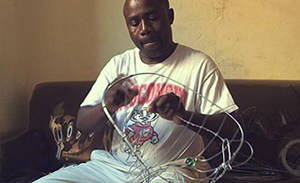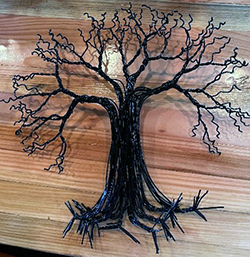

LA MESA, California – Two worlds apart but we speak the same language of art. Olga Worm met artist Bongani Lincoln Khumalo of Cape Town, South Africa, at the Laguna Beach Art-A-Fair Summer Fine Art Festival. Subsequently he came to San Diego County to deliver a piece of art that Worm had purchased. We met at a restaurant in La Mesa.
Khumalo told me he started making toys by hand with wire. He made motorcycles and items that had circles as those were simple for little hands to connect. These items were one dimensional or flat on the surface. He often visited nearby wild animal preserves and started experimenting with three- dimensional designs of animals which took about 5 1/2 years to perfect.
Khumalo took out the items from his bag to show me the work he had done so I could see his medium. The precise handwork and bead placement amazed me.

One item that struck me was the baobab wire tree. He explained that the baobab tree is seen historically in his culture as the Tree of Life. The trunk is a water source which in Africa is survival. The baobab tree represents the resilience of surviving such a harsh climate. The baobab tree also provides nourishment from the leaves and fruit. The bark may be distilled into a tea that can help those suffering from influenza. The baobab provides life.
The same can be said for the Jewish concept of the Tree of Life. The Torah is nourishment for the soul. The many branches reach out to connect our family members and the roots provide life and growth.
Khumalo creates from his wire and bead animals from Africa and Asia. Khumalo said he was upset with poachers and wild game hunters coming from around the world to kill these exotic animals to have them mounted as trophy heads in their homes. He has been making faux life-size trophy heads as an alternative. Many of these animals like lions and elephants are facing extinction and are cherished in Africa.

He utilizes glass beads from Czechoslovakia or India. He has ordered supplies from China, but they were disappointing and poorly made. The wires he purchases locally in South Africa and in different gauges. I asked if he uses gloves, and he said no. We laughed and compared our worn out hands and callouses due to the work we enjoy doing. His creations are not uniform since not all tigers, lions and elephants are the same — proof that he does not use any manufacturing machinery.
He does create the wire frame by using a three-dimensional system on the computer and then follows the pattern with his different wire gauges and pliers. He has employed some of his cousins to string the beads on the wire frames to help complete the structure faster.
Another element of adding light into the trophy head adds dimension to the structure. That had me in wonderment creating this vision in my mind that the colors could be illuminated on walls.
Khumalo is of the lion totem of the Shona tribe on his mother’s side. His father’s side is Zulu, which does not identify with a totem. His wife is of the lion totem from the nearby country of Malawi.
We compared this with marrying within the Jewish faith. Nowadays, marriages are okay between Ashkenazi and Sephardic Jews whereas generations ago such marriages would have been controversial.
The Laguna Art-A-Fair Summer Fine Art Festival ends at 6 p.m., Sunday, September 1. Khumalo can be found at booth D11. Two-dimensional pictures do not describe his amazing handmade creations. It is worth a trip up the coast to see firsthand and to touch the amazing beadwork.
Khumalo, 46, is married to Edith and they have three children, a 21-year-old son, a 16-year-old daughter and a 4-year-old son. His work can be found here. Khumalo may be contacted via this link.
*
Cailin Acosta is the assistant editor of the San Diego Jewish World.
We had a lovely connection with this amazing artist. Thank you for sharing his talent.